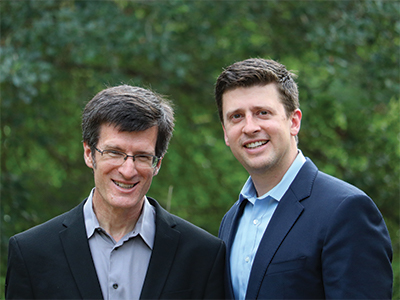 From left: Brothers Chip and Dan Heath are best-selling authors, accomplished educators and “idea collectors.”
From left: Brothers Chip and Dan Heath are best-selling authors, accomplished educators and “idea collectors.”
Think back on the course of your life and you can likely identify a number of defining moments that shaped your personality, your career or your life’s path. Perhaps it was a professional or personal disappointment that set you on a new course, a relationship with a teacher or manager that lifted you to new heights or a chance encounter with someone you eventually married.
These moments may seem the product of happenstance or fate, but best-selling authors Chip and Dan Heath argue that many of these defining experiences can be engineered and used by Toastmasters to fashion more powerful speeches or deliver more enduring leadership lessons. In their new book, The Power of Moments: Why Certain Experiences Have Extraordinary Impact, the Heath brothers recount stories of moments that propelled people in new directions, changing the arc of life paths and leading to new insights that radically altered beliefs and behaviors.
In an interview with the Toastmaster, co-author Chip Heath talked about the book and the research behind it. One of the key messages of The Power of Moments, Chip says, is that while defining moments shape our lives, we don’t have to wait for them to happen.
“We can be the author of those moments,” he says. “I think it’s a skill that more speakers and leaders need, an ability to tap into the emotions of the moment in ways that mobilize audiences or team members in positive directions.”

The Heath brothers, accomplished educators and “idea collectors,” have a history of conducting groundbreaking research that generates compelling new insights. Chip is a professor at the Stanford Graduate School of Business at Stanford University, and Dan is a senior fellow at Duke University’s CASE center, which supports social entrepreneurs. Together the two have written a series of best-selling books that include Made to Stick: Why Some Ideas Survive and Others Die, Switch: How to Change Things When Change is Hard and Decisive: How to Make Better Choices in Life and Work. Made to Stick, which spent 25 months on Business Week’s bestseller list, explores the concept of why some ideas thrive while others die, detailing the anatomy of ideas that “stick” and how to increase your odds of developing them.
“One of the best ways to connect with audiences is by revealing more of your true self to them.”
— CHIP HEATHDefining Moments for Audiences
In the Power of Moments the Heaths examine traits that defining experiences have in common. Research in psychology finds that memories of experiences are not like films that we can rewind and watch from beginning to end. They are more like fragments of particular minutes or hours that stand apart from the surrounding weeks or months.
“What we know is in any time period we forget much of what is going on, but there are consistencies in things we remember,” Heath says. “We tend to remember peaks like the best or worst moments and transitions like beginnings and endings, but we forget many things in the middle. Most lasting memories of college students, for example, occur in the first six weeks of their freshman year. But their junior year tends to be a black hole of memory.”

That’s an important finding when applied to writing or delivering a speech, Heath says, since openings, closings and personal revelations—long stressed as important to presentations—may have even more impact than many speakers realize.
People often miss opportunities to create defining moments, Heath says, but we can learn how to engineer more of them for ourselves and others. What if a leader knew exactly how to turn an employee’s moment of failure into a moment of growth, for example, or a teacher could design a lesson students reflected on for years to come?
Yet the reality is leaders and speakers too often do little to distinguish one week of business or one speech from the next, Heath believes. While creating these moments takes forethought and creativity, the payoffs can last a lifetime, he says.
Four Elements of Defining Moments
In their research the Heath brothers found that defining moments possess at least one of the following four elements. “What we argue is if you understand these principles you can help create the conditions that lead to remarkable moments,” Heath says. “You don’t have to wait for chance to create them.”
Elevation. These are the defining moments that rise above the everyday, Heath says. They might be social occasions that mark transitions (weddings, retirement parties), moments onstage (giving speeches, performing in a play) or experiences that happen spontaneously (an unplanned road trip). To create these, speakers or leaders must enhance sensory pleasures, raise the stakes and if possible “break the script” to add an element of surprise.
Consider the moments of elevation created at the Magic Castle Hotel in Los Angeles, where a red phone is mounted to a wall near the hotel pool. When guests pick up the phone, someone answers, “Hello, Popsicle Hotline.” Guests place an order, and minutes later a staffer wearing white gloves delivers a cherry, grape or orange Popsicle to the caller at poolside. On a silver tray, for free.
People often miss opportunities to create defining moments, Heath says, but we can learn how to engineer more of them for ourselves and others.
“When you phone the Popsicle hotline, is that a defining moment?” the Heaths question in their book. “In the context of a lifetime, certainly not. But in the context of a vacation? Of course it’s a defining moment. When tourists tell their friends about their vacation to Southern California, they’ll say, ‘We went to Disneyland, and we saw the Walk of Fame, and we stayed at this hotel, the Magic Castle, and you won’t believe this, but there’s a phone by the pool . . .’ The Popsicle hotline is one of the moments that defines the trip. And it was an engineered moment—the kind of moment that other hotels often fail to conjure.”
Insight. Heath says defining moments can “rewire” our understanding of ourselves or of the world. “These moments create a deep realization about something in our lives,” Heath says. “It could be a realization that your current job isn’t the right fit for you, the person you’re dating is the one you want to marry or an insight about now being the time to finally start your own business.”

Heath says while moments of insight might appear to come out of nowhere, we can lay the groundwork for creating them by helping others “trip over the truth.” Producing moments of self-insight, on the other hand, requires that we stretch and place ourselves in situations that often involve the risk of failure.
Pride. Moments of achievement or courage capture people at their best and often serve as a springboard for other accomplishments or insights. Heath says creating such moments requires understanding the “architecture” of pride. That means recognizing people for individual achievements, and in other cases planning a series of milestone moments that build on each other in pursuit of a larger goal. It also requires authenticity—delivering recognition that is personal and not programmatic.
“There is power in someone who not only points out areas where you can improve, but also expresses high expectations of your future performance.”
— CHIP HEATHConnection. Defining moments can create a sense of connection that bond us together, such as graduations, weddings, speeches, work triumphs or sporting events. Heath says these moments are strengthened because they are shared with others—groups often unite when they strive together toward a meaningful goal.
The Power of Opening Up
When it comes to speeches, Heath says one way Toastmasters can create more defining moments for audiences is by finding the courage to be more authentic. “One of the best ways to connect with audiences is by revealing more of your true self to them,” Heath says. He points to a study conducted about how strangers interact at bus stops. Those who simply said “hi” to others connected only at the superficial level of small talk, while those who instead said, “I really had a tough day. It’s good to finally be here at the bus stop,” often elicited longer, more meaningful—and memorable—interactions with others.
“It turns out even if you take a baby step toward revealing something about yourself, the conversation and interaction that follows can go much deeper,” Heath says. “If you look at the best speeches, speakers are revealing things about the challenges and difficulties in their lives that others can relate to. That can create defining moments that stay with audiences long after the speech.”

Toastmasters also can create defining moments for their peers during regular club interactions. One such opportunity comes in setting performance expectations, Heath says. An example in The Power of Moments highlights junior high school students who were asked to write an essay about their personal hero. One group of students received a note from their teacher after writing the essay that said, “I’m giving you these comments so that you’ll receive feedback on the paper.” A second group received a different note saying, “I’m giving you these comments because I have very high expectations and I know you can reach them.”
After the papers were returned, students had the option to revise and resubmit them for a better grade. Only 40 percent of those who received the generic feedback note did so, Heath says, while 80 percent of those receiving the “high expectations” note chose to revise their essays, making twice as many corrections as the other group.
“There is power in someone who not only points out areas where you can improve, but also expresses high expectations of your future performance,” Heath says. “That’s a proven way of motivating people to persist in becoming better.”
Dave Zielinski is a freelance writer in Minneapolis, Minnesota, and a frequent contributor to the Toastmaster magazine.



 Previous
Previous
 How To Give Presentations That Stick
How To Give Presentations That Stick
 Previous Article
Previous Article